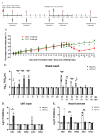The Cold-Adapted, Temperature-Sensitive SARS-CoV-2 Strain TS11 Is Attenuated in Syrian Hamsters and a Candidate Attenuated Vaccine
- PMID: 36680135
- PMCID: PMC9867033
- DOI: 10.3390/v15010095
The Cold-Adapted, Temperature-Sensitive SARS-CoV-2 Strain TS11 Is Attenuated in Syrian Hamsters and a Candidate Attenuated Vaccine
Abstract
Live attenuated vaccines (LAVs) replicate in the respiratory/oral mucosa, mimic natural infection, and can induce mucosal and systemic immune responses to the full repertoire of SARS-CoV-2 structural/nonstructural proteins. Generally, LAVs produce broader and more durable protection than current COVID-19 vaccines. We generated a temperature-sensitive (TS) SARS-CoV-2 mutant TS11 via cold-adaptation of the WA1 strain in Vero E6 cells. TS11 replicated at >4 Log10-higher titers at 32 °C than at 39 °C. TS11 has multiple mutations, including those in nsp3, a 12-amino acid-deletion spanning the furin cleavage site of the S protein and a 371-nucleotide-deletion spanning the ORF7b-ORF8 genes. We tested the pathogenicity and protective efficacy of TS11 against challenge with a heterologous virulent SARS-CoV-2 D614G strain 14B in Syrian hamsters. Hamsters were randomly assigned to mock immunization-challenge (Mock-C) and TS11 immunization-challenge (TS11-C) groups. Like the mock group, TS11-vaccinated hamsters did not show any clinical signs and continuously gained body weight. TS11 replicated well in the nasal cavity but poorly in the lungs and caused only mild lesions in the lungs. After challenge, hamsters in the Mock-C group lost weight. In contrast, the animals in the TS11-C group continued gaining weight. The virus titers in the nasal turbinates and lungs of the TS11-C group were significantly lower than those in the Mock-C group, confirming the protective effects of TS11 immunization of hamsters. Histopathological examination demonstrated that animals in the Mock-C group had severe pulmonary lesions and large amounts of viral antigens in the lungs post-challenge; however, the TS11-C group had minimal pathological changes and few viral antigen-positive cells. In summary, the TS11 mutant was attenuated and induced protection against disease after a heterologous SARS-CoV-2 challenge in Syrian hamsters.
Keywords: COVID-19; SARS-CoV-2; Syrian hamster; cold-adaptation; coronavirus; temperature-sensitive; vaccine.
Conflict of interest statement
The authors declare no conflict of interest.
Figures











Similar articles
-
Immunization with Recombinant Accessory Protein-Deficient SARS-CoV-2 Protects against Lethal Challenge and Viral Transmission.Microbiol Spectr. 2023 Jun 15;11(3):e0065323. doi: 10.1128/spectrum.00653-23. Epub 2023 May 16. Microbiol Spectr. 2023. PMID: 37191507 Free PMC article.
-
Prototype and BA.5 protein nanoparticle vaccines protect against Omicron BA.5 variant in Syrian hamsters.J Virol. 2024 Mar 19;98(3):e0120623. doi: 10.1128/jvi.01206-23. Epub 2024 Feb 2. J Virol. 2024. PMID: 38305154 Free PMC article.
-
Cold-adapted SARS-CoV-2 variants with different temperature sensitivity exhibit an attenuated phenotype and confer protective immunity.Vaccine. 2023 Jan 23;41(4):892-902. doi: 10.1016/j.vaccine.2022.12.019. Epub 2022 Dec 13. Vaccine. 2023. PMID: 36528447 Free PMC article.
-
Hamsters as a Model of Severe Acute Respiratory Syndrome Coronavirus-2.Comp Med. 2021 Oct 1;71(5):398-410. doi: 10.30802/AALAS-CM-21-000036. Epub 2021 Sep 29. Comp Med. 2021. PMID: 34588095 Free PMC article. Review.
-
Should the world collaborate imminently to develop neglected live-attenuated vaccines for COVID-19?J Med Virol. 2022 Jan;94(1):82-87. doi: 10.1002/jmv.27335. Epub 2021 Sep 21. J Med Virol. 2022. PMID: 34524688 Free PMC article. Review.
Cited by
-
Immunogenicity and Tolerability of a SARS-CoV-2 TNX-1800, a Live Recombinant Poxvirus Vaccine Candidate, in Syrian Hamsters and New Zealand White Rabbits.Viruses. 2023 Oct 21;15(10):2131. doi: 10.3390/v15102131. Viruses. 2023. PMID: 37896908 Free PMC article.
-
Amino acid substitutions in NSP6 and NSP13 of SARS-CoV-2 contribute to superior virus growth at low temperatures.J Virol. 2025 Mar 18;99(3):e0221724. doi: 10.1128/jvi.02217-24. Epub 2025 Feb 12. J Virol. 2025. PMID: 39936915 Free PMC article.
-
SARS-CoV-2 virus lacking the envelope and membrane open-reading frames as a vaccine platform.Nat Commun. 2025 May 14;16(1):4453. doi: 10.1038/s41467-025-59533-4. Nat Commun. 2025. PMID: 40360482 Free PMC article.
-
Rat hepatitis E virus cross-species infection and transmission in pigs.PNAS Nexus. 2024 Jul 1;3(7):pgae259. doi: 10.1093/pnasnexus/pgae259. eCollection 2024 Jul. PNAS Nexus. 2024. PMID: 39035038 Free PMC article.
-
Engineering a recombination-resistant live attenuated vaccine candidate with suppressed interferon antagonists for PEDV.J Virol. 2025 Jul 22;99(7):e0045125. doi: 10.1128/jvi.00451-25. Epub 2025 Jun 12. J Virol. 2025. PMID: 40503881 Free PMC article.
References
-
- Evans J.P., Zeng C., Carlin C., Lozanski G., Saif L.J., Oltz E.M., Gumina R.J., Liu S.L. Neutralizing antibody responses elicited by SARS-CoV-2 mRNA vaccination wane over time and are boosted by breakthrough infection. Sci. Transl. Med. 2022;14:eabn8057. doi: 10.1126/scitranslmed.abn8057. - DOI - PMC - PubMed
-
- Altarawneh H.N., Chemaitelly H., Hasan M.R., Ayoub H.H., Qassim S., AlMukdad S., Coyle P., Yassine H.M., Al-Khatib H.A., Benslimane F.M., et al. Protection against the Omicron Variant from Previous SARS-CoV-2 Infection. N. Engl. J. Med. 2022;386:1288–1290. doi: 10.1056/NEJMc2200133. - DOI - PMC - PubMed
Publication types
MeSH terms
Substances
LinkOut - more resources
Full Text Sources
Other Literature Sources
Medical
Miscellaneous

